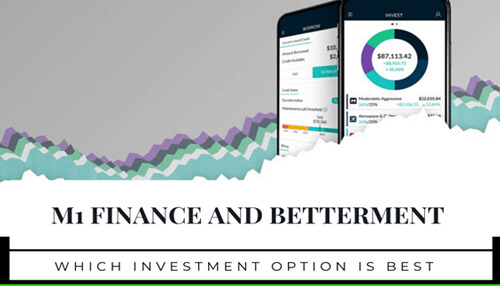M1 Finance and Betterment are leading investment platforms for low-cost investment. Betterment is suitable for passive investing, while M1 Finance is perfect for DIY investing. However, other factors may influence your decision based on your personal needs. Let’s compare the two platforms.
M1 Finance
M1 Finance is an American financial services company that refers to itself as “The Finance Super App”, and it is not an empty boast.
Founded in 2012, it has been available to the public since 2015 and so far, has accumulated more than $6 billion in assets under management.
As an amalgamation between a Robo-Advisor and a traditional financial advisor, it delivers commission-free trading making this simple to use for less experienced investors. It takes minimal time to monitor your investments, making it ideal for almost any investor.
You don’t need any money to open your account and set up your portfolio. But you will need at least $100 before you can start investing.
You build your portfolio using investment Pies.
Each asset you choose is one slice of your pie. The slices can be bonds, stock or exchange Traded Funds (ETFs). You can choose an asset allocation based on your risk tolerance from a selection of 60 different pies, each based on modern portfolio theory.
You can then remain with your chosen allocation or make your asset selections within your pie.
M1 Finance automatically rebalances your pie so that you remain within your chosen risk tolerance.
Once your portfolio has been chosen, then you can select the account type that fits your needs:
- Individual Account
- Joint Account
- Retirement Accounts (Traditional IRA, Roth IRA, SEP IRA)
- Trust Accounts
- Custodial Accounts (UTMA, UGMA)
You can borrow against your investment at an interest rate of 3.5% with a feature called M1 Borrow. You need a minimum balance of $5,000.
M1 Spend is a free checking account you receive automatically and comes with one ATM fee reimbursed per month.
M1 Plus is a newer feature that offers Smart Transfers. You can also get custodial accounts and borrow money, at the lower interest rate set at just 2%. Your checking account earns 1% interest, and you get 1% cashback when you spend using your debit card, four ATM fees/month are reimbursed, and any international fees are waived.
M1 Plus is free for the first year then $125/year.
M1 Finance is suitable for:
- Long-term investors
- Dividend investors
- Investors who want customized investments
- Investors who want to be hands-off, and
- New investors – M1 does the work for you, you don’t need to worry about rebalancing and other aspects of investing that help you grow your wealth.
If you are a day trader, M1 Finance does not allow you to trade throughout the day, so this is not the option for you. And if you want to invest in mutual funds, again you should look elsewhere.
Here you can read another comprehensive review of M1 Finance.
To get started with M1 Finance you can click on this link.
Betterment
This platform was one of the first and therefore has a longer track record of performance than most competitors. You can invest in Stocks and Bonds with no minimum contributions and a tiny fee of just 0.25%.
A portfolio will be created where your money is invested into mutual funds, bond funds and exchange-traded funds (ETFs). You can also buy fractional shares which are ownership of just a part of the value of a share.
Betterment does it all for you. It will even show you how much you need to fund your retirement. Its goal tracking allows you to see how your investment will grow. If you are making automatic deposits, you don’t have to do a thing.
If your investment values move and cause your account to drift away from your set investment strategy by more than 3%, automatic rebalancing will bring your investment back into line for you.
But Betterment is more than just algorithms, it can also help your investment grow with:
- Automated diversification
- Tax-Coordinated Portfolio
- Reinvestment of dividends; and
- Tax-loss harvesting – that’s a valuable feature for larger investors and can reduce their tax bills considerably.
From 2004 to 2020 Betterment’s 75/25 allocation mix fund averaged 8.2% growth.
For those with over $100,000, you can access the Flexible Portfolio feature and change your asset allocation mix. You can also access their Financial Planners at no cost. With a lower balance, the cost to talk to a Financial Planner is a low $199.
Here is a review with more details about Betterment.
M1 Finance Vs Betterment
M1 Finance is better suited to investors who:
- Are active traders
- Require only occasional account transfers
- Require only occasional withdrawals
- Need multiple account types, and
- Keep lower net worth balances.
Betterment is better suited to investors who:
- Are passive investors
- Require frequent transfers
- Require more withdrawals
- Require investment advice from a real person, and
- Have higher net worth balances.
M1 Finance offers better features than Betterment. It allows you to pick individual investments and provides a hands-off approach. That way you get complete control over your investment.
If you like to choose your own securities, click here to get started with an M1 account.
To benefit from an algorithm-enabled robo-advisor portfolio with the option to also speak to financial advisors when needed, click here to open a Betterment account.




